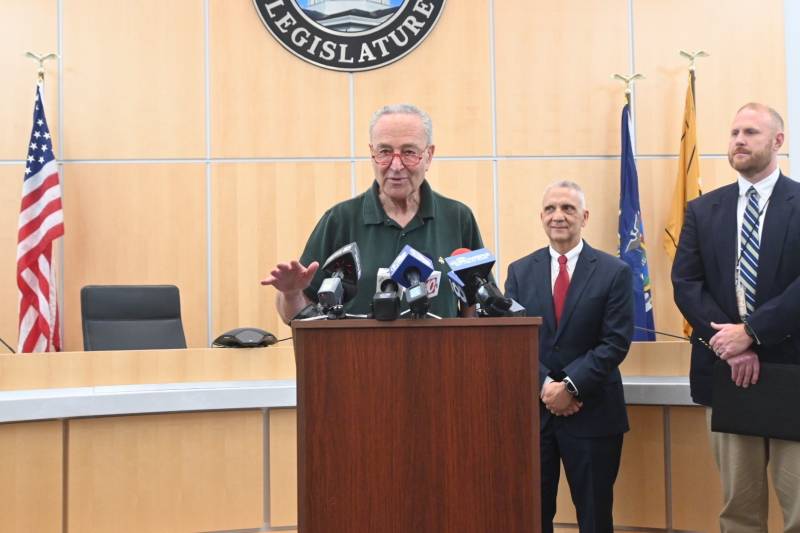Following several recent major fentanyl busts in Orleans County, U.S. Senate Majority Leader Charles E. Schumer today launch a major new push to upend the flow of fentanyl in Orleans, Western NY, and the Finger Lakes-Rochester area.
Schumer detailed the new bipartisan legislation, the FEND Off Fentanyl Act, he included in the Senate-passed National Defense Authorization Act (NDAA) that would not only allow President Biden to place sanctions on China for its role in contributing to our nation’s fentanyl epidemic and declare international fentanyl trafficking a national emergency.
Schumer is now demanding that the House pass the measure to combat the flow of fentanyl from China and Mexico before it reaches places like Orleans County and Upstate NY.
“From Buffalo to Rochester to right here in Orleans County, fentanyl continues to take the lives of far too many New Yorkers each and every day. We must make getting this deadly drug off of our streets and out of the U.S. a top priority, and the just passed Senate defense bill provides a rare window of opportunity to do just that,” said Senator Schumer.
“That’s why I’m now calling on the U.S. House of Representatives to quickly pass this measure and help upend the flow of fentanyl overseas, far before it reaches places like Orleans County and Western NY. By including the FEND Off Fentanyl Act in the NDAA and ensuring that we can place tough sanctions on China for turning a blind eye to this issue and giving these deadly exports the green light, I am working to keep our communities safe in Upstate NY and across the nation. Too many lives have been lost, and too many others are at stake, especially here in New York.”
“The opioid epidemic and fentanyl crisis is a significant public health and public safety issue,” stated Paul Pettit, Public Health Director of the Genesee and Orleans County Health Departments (GO Health). “Over the past five years, there have been 53 fatal overdoses in Genesee County and 23 fatal overdoses in Orleans County, with additional deaths still pending official causes of death. In 2022, 83% of all fatal opioid overdoses in both counties involved fentanyl, which demonstrates how serious this problem is in our communities. This trend is something that is also seen across New York State and throughout the nation. I applaud Senator Schumer for his support of this amendment that will include stopping the spread of illegal fentanyl at its source.”
Joseph V. Cardone, Orleans County District Attorney said, “In my 31 years as District Attorney this fentanyl crisis is by far the most devastating issue law enforcement has had to combat. While not one gram of this poison is produced in this Country it is daily killing our youth in every community in America. Clearly stopping fentanyl from entering our country needs to be a priority.”
Schumer said the Senate passage of the NDAA bill just days ago included a bipartisan plan to officially declare international fentanyl trafficking a national emergency and give the president special powers to impose tough sanctions on China, Mexico, or any other relevant fentanyl supply chain hub. The House passed its own version of the National Defense Authorization Act earlier in July, but now that Schumer has passed NDAA in the Senate, lawmakers will need to reconcile the Senate bill and the House bill by negotiating a compromise version that can pass both chambers.
Fentanyl is trafficked into the United States primarily from China and Mexico, and is responsible for the ongoing fentanyl epidemic in Upstate NY and across the country. China is the world’s largest producer of illicit fentanyl, fentanyl analogues, and their immediate precursors.
From China, those substances are shipped primarily through express consignment carriers or international mail directly to the United States, or, alternatively, shipped directly to transnational criminal organizations in Mexico, Canada, and the Caribbean. Some officials estimate that China is responsible for over 90 percent of the illicit fentanyl found in the U.S.
Schumer explained to disrupt the flow of illicit opioids into the United States, he pushed to include the FEND Off Fentanyl Act into the just-passed Senate defense bill. The bill does the following:
- Declares that the international trafficking of fentanyl is a national emergency.
- Requires the President to sanction transnational criminal organizations and drug cartels’ key members engaged in international fentanyl trafficking.
- Enables the President to use proceeds of forfeited, sanctioned property of fentanyl traffickers to further law enforcement efforts.
- Enhances the ability to enforce sanctions violations thereby making it more likely that people who defy U.S. law will be caught and prosecuted.
- Requires the administration to report to Congress on actions the U.S. government is taking to reduce the international trafficking of fentanyl and related opioids.
- Allows the Treasury Department to utilize special measures to combat fentanyl-related money laundering.
- Requires the Treasury Department to prioritize fentanyl-related suspicious transactions and include descriptions of drug cartels’ financing actions in Suspicious Activity Reports.
Fentanyl is a powerful synthetic opioid that is 30 to 50 times more potent than heroin. It is short-acting and cannot be seen, tasted, or smelled when mixed with other drugs. While pharmaceutical fentanyl is prescribed for severe pain and end-of-life care, non-pharmaceutical fentanyl is produced illicitly and is now common in the illicit drug supply.
The presence of non-pharmaceutical fentanyl in Orleans County, Western NY, and the Finger Lakes has dramatically increased the number of overdose deaths, and fentanyl is now the “leading cause of death for Americans 18 to 45 years old.”
Since 2020, Orleans County has seen 14 deaths from opioid overdoses, 76 outpatient emergency department visits, and 558 admissions to OASAS-certified substance abuse disorder treatment programs. Several recent examples have underscored the prevalence and danger of fentanyl in Orleans County.
Earlier this year, 48 members of a local drug ring were charged for selling fentanyl and other opioids across the Finger Lakes region and Orleans. Law enforcement seized more than 10 kilograms of fentanyl and 10 kilograms of cocaine, $9 million worth of illegal drugs.
Similarly, a raid earlier in the year seized 114 fentanyl pills disguised as other drugs, and just last month, U.S. Attorney Trini Ross announced the guilty plea of a dealer who intended to distribute over 400 grams of fentanyl into both Medina and Rochester. Back in 2018, the rate of overdose deaths jumped to 27.1 per 100,000 – much higher than state and national averages. That number prompted health department officials and others to allocate more resources to the problem.
Looking at the broader region, in 2022 alone, the Finger Lakes saw 295 deaths from opioid overdoses, 843 outpatient emergency department visits, and 5,744 admissions to OASAS-certified substance abuse disorder treatment programs.
Similarly, the Buffalo/Western New York saw 410 deaths from opioid overdoses, 856 outpatient emergency department visits, and 5,036 admissions to OASAS-certified substance abuse disorder treatment programs. In 2021, nearly 107,000 Americans died from an overdose, and 65% of overdose deaths were caused by fentanyl.
Last year alone, the Drug Enforcement Administration seized over 379 million deadly doses of fentanyl - enough to supply a lethal dose to every American.
Additionally, Xylazine has been a contributing factor in fatal overdoses across Monroe County for years, with over 180 deaths tied to the lethal drug since 2019. Xylazine opioids caused 59 fatal overdoses in Monroe County and 3 in Wayne County in 2022 and were suspected in 10 fatal OD cases earlier this year in Wayne County. Erie County had 17 confirmed Xylazine deaths since 2022. Xylazine has also been found in drugs seized in cases in Orleans and Genesee County beginning in 2019. Xylazine was involved in four opioid-related deaths In Orleans County and Xylazine was involved in 6 opioid-related deaths in Genesee County.
Schumer has also been sounding the alarm on the spread of Xylazine, a dangerous, skin-rotting drug that has been making its way to Upstate NY streets, already taking the lives of hundreds of New Yorkers. After a horrific wave of overdoses and deaths in Upstate NY tied to Xylazine earlier this year, Schumer stood with local law enforcement and health officials in communities across the Finger Lakes and Upstate NY to call for further federal action.
In April, the Biden Administration heeded Schumer’s calls and declared xylazine an emerging threat to the United States, a major step in eradicating the illicit supply of the deadly drug once and for all.
This past June, the Senate took another major step in the fight against xylazine by passing the ‘TRANQ Act,’ which directs the National Institute of Standards and Technology (NIST) to support research and other activities related to identifying xylazine, develop new tests for detection, and establish partnerships with organizations on the front lines of this battle.
Most recently, the Biden Administration took even further action implementing many of the actions Schumer highlighted releasing a new Xylazine Response Plan, to coordinate an inter-agency governmental response to help build the treatment, data, and research capabilities that are needed to help those impacted by xylazine.
“I’m glad the Biden administration has laid out a plan to fight the insidious spread of this Narcan-resistant, skin-rotting, zombie drug. This is a major step in the fight to eradicate this awful scourge in Orleans and across Western NY once and for all,” Schumer added.
“This plan will save lives. I know it won’t be easy to get xylazine off our NY streets for good, and ultimately, we will need more funding for prevention, recovery, and treatment programs for those struggling with addiction. That’s why I am committed, now more than ever, to continuing to push for Congress to provide the necessary funding to increase resources that fight this epidemic on the front lines and rid communities in Upstate NY and across the nation of this terrifying drug.”
The new action taken outlined in the Xylazine Response plan includes increased resources for:
- Testing - Improve the xylazine testing being conducted in community and law enforcement settings, which is currently uneven across the United States, impeding the development of a full national threat picture. Improved clinical testing to detect xylazine in drug products and postmortem toxicology settings will provide important information about this emerging threat.
- Epidemiology and Comprehensive Data Systems - Gather additional information to inform, implement, and evaluate a comprehensive and coordinated public health and public safety response, including xylazine sourcing and determining to what degree persons are encountering xylazine alone or xylazine-adulterated products.
- Evidence-Based Prevention, Harm Reduction, and Treatment Implementation and Capacity Building - Address the concerning health challenges associated with xylazine by developing and disseminating best practices based on emerging clinical efforts with patients exposed to xylazine, evaluating potential xylazine overdose reversal strategies, and prioritizing efforts to educate and equip healthcare providers and first responders on best practices to treat flesh wounds associated with xylazine.
- Source and Supply Information and Intelligence; and Supply Reduction Actions - Help inform public health and public safety officials about the sources of xylazine in the illicit drug supply chain and markets in the United States by determining whether it is diverted from legitimate supplies and/or synthesized for illicit use, enhancing ability and jurisdiction to regulate the supply chain, and identifying and develop additional targeted and coordinated law enforcement actions and efforts to reduce the illicit supply of xylazine.
- Regulatory Control and Monitoring Options - Assess regulatory options to disrupt the production, distribution, illegal sale and trafficking, and exposure to illicit xylazine, as the particular chemical nature of this non-opioid tranquilizer may pose challenges for traditional methods of testing drugs in scheduling decisions.
- Basic and Applied Research - Conduct research to evaluate as quickly as possible potential xylazine antidotes in humans, drug-drug interactions, population-level health, social, equity, and economic drivers and consequences of exposure to fentanyl adulterated with xylazine, and identify the most promising clinical stabilization, detoxification, and treatment protocols.
Schumer has a long history of fighting for additional resources to support law enforcement and boost addiction recovery services. Most recently, he secured $445 million for Comprehensive Addiction and Recovery Act (CARA) grants, an increase of $30 million from FY22.
He secured $16 million for the COPS anti-methamphetamine program and $35 million for the COPS anti-heroin task force that helps ensure the safety of local communities. He also secured $302 million for the High-Intensity Drug Trafficking Area (HIDTA) program in this year’s budget.
In addition, Schumer led the fight to secure $44.9 billion to address opioid abuse in the most recent Omnibus, an increase of over $345 million over the previous year. That includes nearly $1.6 billion in State Opioid Response grants, $100 million more for the Substance Abuse Prevention and Treatment program, $111 million for medication-assisted treatment programs, $145 million for programs targeted towards rural communities, and more.



